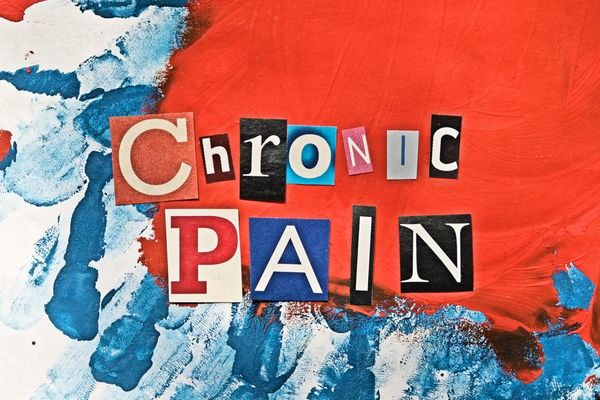A couple of weeks ago, I caught a tiny glimpse of what it's like to live with chronic pain. For two days, I suffered the agony of an abscessed tooth before finally going to the emergency room and getting a prescription for antibiotics. I already had strong painkillers at home and the doctor told me to double the dose. Still, that night I experienced the worst pain I've had since giving birth. I lay awake until 4 a.m., completely focused on the pain.
The next day, when the pain had subsided a bit, I thought about what it must be like to live with pain as a constant companion — something one in three women face. I took stock of how fortunate I am to be able to afford a trip to the ER, pay for the antibiotics and rest safely in bed in my own home. On the other hand, I waited two full days to seek medical attention because I didn't think a toothache was a valid reason to bother a doctor on the weekend.
All of those factors informed my experience with the pain. When I went to the ER, however, the doctor only asked about my physical symptoms. He didn’t inquire into my living situation, mental health or other stressors that may have affected the pain. I was dealing with acute pain, but this approach is common with chronic pain as well.
“Normally, chronic pain is dealt with with a one-size-fits-all approach,” said Dr. Monica Mallampalli, who has given numerous presentations on chronic pain and is HealthyWomen’s senior advisor of scientific and strategic initiatives. “You just have the standard medications — you have the standard treatment — but it doesn't work for everybody. One size does not fit all.”
According to a study published by the Centers for Disease Control and Prevention in 2018, an estimated 50 million Americans suffer from chronic pain, with 19.6 million suffering high-impact chronic pain. The study found a higher prevalence of chronic pain among older adults, those living in poverty and those with public health insurance. The study also linked chronic pain to numerous physical and mental conditions, including anxiety and depression.
Traditionally, health care providers don’t take any of these additional life factors into account when treating chronic pain, but pain is subjective so those factors are relevant. Women and men experience pain differently, but each woman experiences pain differently, too, which is why the one-size-fits-all approach doesn’t work.
“There’s a push to treat pain at an individualized level and for that, you need to understand where the patient is coming from,” Mallampalli said. “What type of background do they have? What are they going through?”
She added that a primary care physician or pain specialist treating a patient should also work with a mental health specialist.
She went on to tell me about a more individualized, holistic approach. The biopsychosocial model of disease, which was developed in the late 1970s by George Engel, has been widely applied to pain (as well as other conditions and chronic illnesses).
I reached out to Mary Driscoll, Ph.D., an assistant professor of psychiatry at Yale School of Medicine, to delve deeper. Driscoll’s research focuses on evidence-based interventions for the management of chronic pain for women.
An individualized approach
“Biopsychosocial is basically short for biological, psychological and social,” Driscoll explained. “It's the idea that there's a confluence of biological, psychological and social factors and experiences that are all at play when someone experiences pain. So, for example, biologically, in the case of a woman with migraines, a hormone might be at play.
“Psychologically, we know that certain things like depression and anxiety, trauma or PTSD can exacerbate the pain experience and, in some cases, they can also contribute to the expression of pain. It’s not that the pain isn’t real, but there's a lot of overlap. From a social standpoint, there are contingencies in our world that can exacerbate pain or interfere with its management. For example, somebody who has a very physically demanding job or young children to care for may struggle more to manage pain,” Driscoll said.
Let’s say there are two women with chronic headaches. One struggles financially and has little emotional support; the other has plenty of financial resources and a strong support system. The first woman may have a higher pain level due to her particular circumstances, whereas it may not be as bad for the second woman.
“That’s why we say the pain is worse for low-income women or with a woman who already has mental health issues,” Mallampalli said. “That’s where that relationship comes in. If we’re going to treat pain, we have to take mental health issues into account.”
Conversely, Driscoll explained that the traditional medical model prioritizes the disease and fixing the disease. However, chronic pain involves the biological, psychological and the social, so focusing on one factor at the exclusion of others is rarely sufficient.
While the biopsychosocial model is well-known in the medical community, it isn’t yet universally adopted. Until it is, women with chronic pain can advocate for themselves by giving their medical providers more information about the specifics of their situation, and asking that those factors be considered in their treatment.
“We as humans don't exist in a vacuum and the biological factors, the psychological factors and the social factors all intersect and we really can't parse out any one of them,” Driscoll said.
“When you're dealing with chronic pain or any chronic condition, intervening at all of these levels is really important, because each and every one of these things have the ability to either make the situation better or make the situation worse.”
Resources:
HealthyWomen Chronic Pain Summit Presentations
Executive Summary of HealthyWomen’s Chronic Pain Survey







